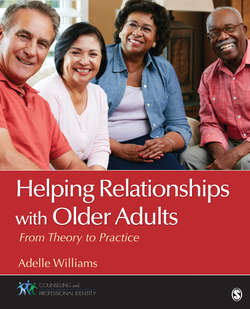Читать книгу Helping Relationships With Older Adults - Adelle M. Williams - Страница 42
На сайте Литреса книга снята с продажи.
Learning and Memory
ОглавлениеLearning and memory involve the encoding, storage, and retrieval of information. Sensory memory is the earliest stage (i.e., visual, auditory, tactile), which is inherently unstable and decays rapidly. There is no age-related change. Primary (short-term) memory occurs after transfer of sensory memory. There is no loss with age. Secondary (long-term) memory persists for hours, days, and years. There is a decline with age, mostly in free recall; however, recognition is well preserved. The universal temporary decline in the ability to retrieve names generally begins early in middle age and worsens over time. The lost name is almost always retrieved soon after the episode. The phenomenon does not predict any neurodegenerative disorder, such as Alzheimer’s disease. Encoding strategies such as mnemonics, mental hierarchies, and clusters help with retrieval; however, older adults use them less frequently. Training provides long-lasting improvements.
The most widely seen cognitive change associated with aging is that of memory. Memory function can be divided into four sections: episodic memory, semantic memory, procedural memory, and working memory. Episodic and semantic memories are most important with regard to aging. Episodic memory is a unique memory of a specific event or a personal memory of an experience. An example of an episodic memory would be a memory of the first day at school, last week’s important meeting, or learning that Paris is the capital of France. Episodic memory is thought to decline from middle age onward. This is particularly true for recall in normal aging and less so for recognition (Nyberg & Blackman, 2004).
Semantic memory refers to general facts and knowledge. Examples of this type of memory include knowing that Paris is the capital of France, that 10 millimeters make up a centimeter, or that Mozart composed The Magic Flute. Semantic memory increases gradually from middle age (30–45 years) to the young elderly (46–60 years) but then declines in the very elderly (61–75 and 76–90 years) (Nyberg & Blackman, 2004). It is unclear why these changes occur, and it has been hypothesized that the very elderly have fewer resources to draw from and that their performance may be affected in some tasks by slower reaction times, lower attention levels, slower processing speeds, detriments in sensory and/or perceptual functions, or potentially a lesser ability to use strategies (Cabeza, 2004; Cabeza, Daselaar, & Dolcos, 2004; Lustig & Buckner, 2004; Nyberg & Blackman, 2004).
Davis and colleagues (2003) examined memory performance in four age groups (30–45 years, 46–60 years, 61–75 years, and 76–90 years) on a multitrial verbal recall task with 20-minute and 1-day delay free recall and recognition trials. The rate of acquisition across five learning trials was similar for all ages except the youngest group. Despite the similarities, the level of acquisition achieved was lower in the two oldest groups. Subjective organization decreased with age (tendency for individuals to impose greater organization of words, either no improvement or a decrease in sequential organization) but remained strongly related to the number of words during acquisition for all age groups. The two oldest groups demonstrated significant declines in words recalled on the 20-minute and 1-day delay trials. Thus, it was concluded that many aspects of free recall are impaired with age, and variance measurement of recall showed greater interindividual differences with increasing age. This increase in individual differences could reflect a single form of age-related memory impairment, or it could indicate that memory impairment in the elderly is due to multiple processes (Davis et al., 2003).
Physically, the function of the prefrontal cortex is altered with aging. There is evidence of atrophy in gray and white matter within the prefrontal cortex, which results in slowed neurotransmissions, which causes slowed reactions, thinking, and signaling among other functions (Head et al., 2004). The brain of older adults works harder and uses both the right and left hemispheres (bilateral recruitment) for functions that young adults can perform unilaterally. These activities include the initiation of goal-related task strategies, and with age the brain will recruit additional prefrontal regions to help perform the task (Kensinger, 2009). The hippocampus (part of the brain involved in emotions, memory, learning, and the autonomic nervous system) is the other region of the brain that shows large decline with age and affects the encoding and retrieval phases of recollective and associate memory, which tend to be underused in aging adults. Recollective memory is recall in memory, which is the retrieval of events or information from the past, whereas associate memory is the ability to learn or remember the relationship between unrelated items (e.g., name of someone you just met or aroma of a particular perfume). The changes within the hippocampus correlate with reduced performance on memory tasks.
As adults progress through their later years, many note the decline in their ability to recall bits of information and perform mental calculations. Though reflections about cognitive aging are expected to grow more pessimistic with the passage of chronological time, people’s life courses elapse in ways besides objective days, months, calendar, and years. Therefore, age identity may be a more telling indicator of dispositions toward cognitive aging than chronological age. Subjective evaluations of age are an important aspect of the self with implications for well-being (Westerhof & Barrett, 2005).
